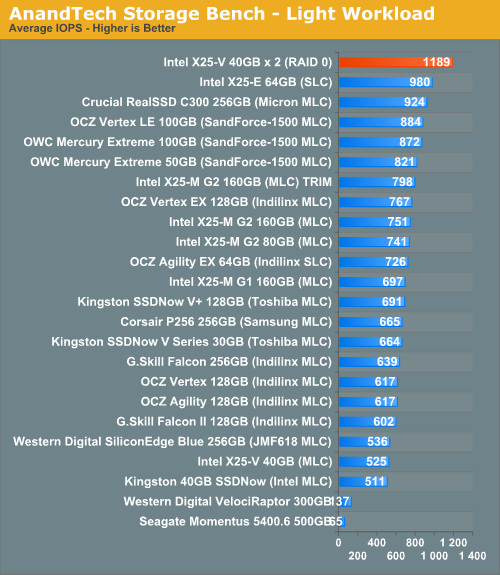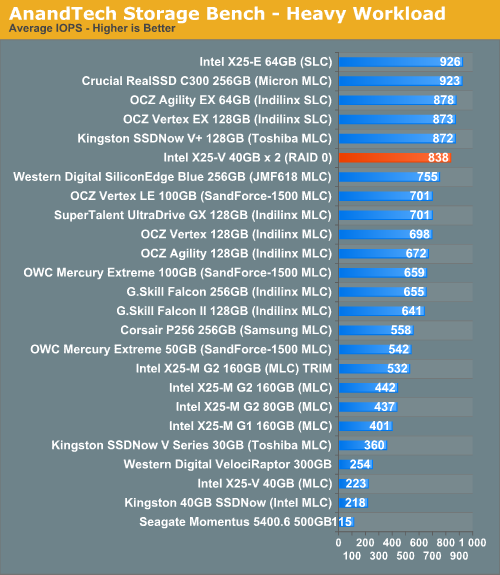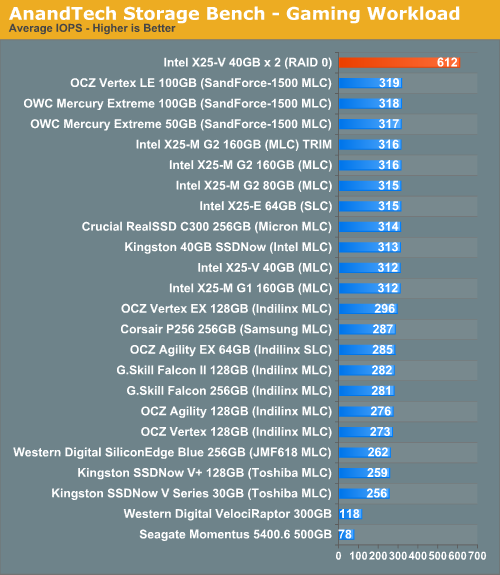Intel X25-V in RAID-0: Faster than X25-M G2 for $250?
by Anand Lal Shimpi on March 29, 2010 8:59 PM ESTAnandTech Storage Bench
The first in our benchmark suite is a light usage case. The Windows 7 system is loaded with Firefox, Office 2007 and Adobe Reader among other applications. With Firefox we browse web pages like Facebook, AnandTech, Digg and other sites. Outlook is also running and we use it to check emails, create and send a message with a PDF attachment. Adobe Reader is used to view some PDFs. Excel 2007 is used to create a spreadsheet, graphs and save the document. The same goes for Word 2007. We open and step through a presentation in PowerPoint 2007 received as an email attachment before saving it to the desktop. Finally we watch a bit of a Firefly episode in Windows Media Player 11.
There’s some level of multitasking going on here but it’s not unreasonable by any means. Generally the application tasks proceed linearly, with the exception of things like web browsing which may happen in between one of the other tasks.
The recording is played back on all of our drives here today. Remember that we’re isolating disk performance, all we’re doing is playing back every single disk access that happened in that ~5 minute period of usage. The light workload is composed of 37,501 reads and 20,268 writes. Over 30% of the IOs are 4KB, 11% are 16KB, 22% are 32KB and approximately 13% are 64KB in size. Less than 30% of the operations are absolutely sequential in nature. Average queue depth is 6.09 IOs.
The performance results are reported in average I/O Operations per Second (IOPS):

That's right. A pair of X25-Vs in RAID-0 offers better performance in our light workload than Crucial's RealSSD C300, a $799 drive. The performance scaling is more than perfect, but that's a side effect of the increase in capacity. Remember that Intel's controller uses any available space on the SSD as spare area to keep write amplification at a minimum. Our storage bench is based on a ~34GB image, which doesn't leave much room for the 40GB X25-V to keep write amplification under control. With two our total capacity is 74.5GB, which is more than enough for this short workload. With the capacity cap removed, the X25-Vs can scale very well. Not nearly twice the performance of an X25-M G2, but much faster than a single drive from Intel.
If there’s a light usage case there’s bound to be a heavy one. In this test we have Microsoft Security Essentials running in the background with real time virus scanning enabled. We also perform a quick scan in the middle of the test. Firefox, Outlook, Excel, Word and Powerpoint are all used the same as they were in the light test. We add Photoshop CS4 to the mix, opening a bunch of 12MP images, editing them, then saving them as highly compressed JPGs for web publishing. Windows 7’s picture viewer is used to view a bunch of pictures on the hard drive. We use 7-zip to create and extract .7z archives. Downloading is also prominently featured in our heavy test; we download large files from the Internet during portions of the benchmark, as well as use uTorrent to grab a couple of torrents. Some of the applications in use are installed during the benchmark, Windows updates are also installed. Towards the end of the test we launch World of Warcraft, play for a few minutes, then delete the folder. This test also takes into account all of the disk accesses that happen while the OS is booting.
The benchmark is 22 minutes long and it consists of 128,895 read operations and 72,411 write operations. Roughly 44% of all IOs were sequential. Approximately 30% of all accesses were 4KB in size, 12% were 16KB in size, 14% were 32KB and 20% were 64KB. Average queue depth was 3.59.

We see the same super scaling here thanks to the increase in capacity offered by RAIDing two of these drives together. The overall performance is great. We're at around 91% better performance than a single X25-M G2.
The gaming workload is made up of 75,206 read operations and only 4,592 write operations. Only 20% of the accesses are 4KB in size, nearly 40% are 64KB and 20% are 32KB. A whopping 69% of the IOs are sequential, meaning this is predominantly a sequential read benchmark. The average queue depth is 7.76 IOs.

As we saw in our sequential read tests, the X25-Vs in RAID-0 can do very well in sequential read workloads. Our game loading test has the X25-V RAID array beating even Crucial's 6Gbps RealSSD C300.










87 Comments
View All Comments
morphin1 - Saturday, April 3, 2010 - link
Thank you a lot Anand for the reply and clearing that up for me.The Sony Vaio Z has samsung MMCRE28G drives(2*64GB).
I am holding my buying decision on your recomendation. What say you? Will the above drives be rendered useless overtime with Trim?
Thanks you a lot for your time.
I have been reading AT for over 2years now and love the indepth reviews you guys do as opposed to other sites.
Love this site.
Cheers
morphin1 - Saturday, April 3, 2010 - link
How will the samsung drive fare without TRIM.I wrote incorrectly when i said With TRIM.
Chloiber - Sunday, April 4, 2010 - link
What's the QD of the random read/write tests (did I miss it?)?AnalyticalGuy3 - Wednesday, April 7, 2010 - link
Suppose I have four X25V's in RAID 0 using the Intel ICH10. Two questions:
1) Just to confirm my understanding, a random read request smaller than the stripe size should only access one member of the array, correct?
2) Suppose the queue contains four random read requests smaller than the stripe size. And suppose I'm really lucky -- each random read request happens to tap a different member of the array. Is the ICH10 smart enough to dispatch all four random read requests in parallel?
boostcraver - Tuesday, April 13, 2010 - link
Anand,I'm sure I read this article thoroughly but I didn't see exactly what the RAID configuration was - whether onboard raid, dynamic disks in Windows, or a dedicated RAID add-in card.
Once that is explained, it'd be great if we could get a benchmark comparison of these different RAID technologies. Something to justify the simplicity of using Windows dynamic disks for raid0 / raid1 configuration, or to spend the extra bucks on a SAS/SATA raid card. Since everyone has been supporting RAID0 for the best performance, we should understand exactly the options at hand.
Thanks for the great articles.
- boostcraver
Shin0chan - Friday, June 18, 2010 - link
"A standard 80GB X25-M wouldn't be this bad off, the X25-V gets extra penalized by having such a limited capacity to begin with. You can see that the drive is attempting to write at full speed but gets brought down to nearly 0MB/s as it has to constantly clean dirty blocks. Constant TRIMing would never let the drive get into this state. It's worth mentioning that a desktop usage pattern shouldn't get this happen either. Another set of sequential writes will clean up most of this though"Hi guys, I understood where this topic was going until I read the last sentence of this paragraph and this lost me. I'm trying to understand this from a normal day-to-day usage train of thought; the performance degradation is mind blowing.
So how would I do a bunch of sequential writes to the drive if my OS and Apps would be sitting on this? (They normally take up about 60-65GB for me.) From my understanding, this means I would have to use Secure Erase and restore from say a complete backup.
Please enlighten me lol. Thanks.
chaosfox97 - Tuesday, August 3, 2010 - link
If it got over loaded and you were regretting putting it into RAID-0, couldn't you just change it to normal, use TRIM, and change it back to RAID-0?